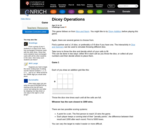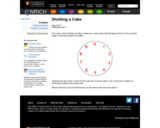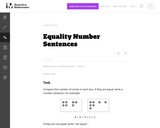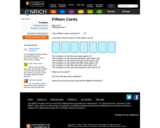
This three-act math task utilizes videos and questioning to help students explore addition and subtraction within 50.
- Subject:
- Mathematics
- Material Type:
- Activity/Lab
- Provider:
- GFletchy
- Author:
- Graham Fletcher
- Date Added:
- 10/25/2022

This three-act math task utilizes videos and questioning to help students explore addition and subtraction within 50.

In this Cyberchase video segment, Matt uses subtraction to help Digit figure out how much time he has left in a cooking contest with Hacker.

This Flash game develops students' computational fluency and flexibility. It can be played alone or with others. Players choose 6 face-down number cards, and the applet provides a target number. Number cards include one each of 25, 50, 75, and 100, and multiple copies of 1 to 10. The goal is to use the selected numbers and the four basic operations (addition, subtraction, multiplication, division) to arrive at the target. Players can ask the applet to Show a Solution, although others may be possible. Several rule and scoring variations are suggested. A full screen option facilitates use on an interactive board. (This game is not self-checking.)

In these lessons students will explore the paintings of Horace Pippin and Wayne Thiebaud and the mobiles of Alexander Calder to discover and practice math and visual art concepts. Background and biographical information about the work of art and artist, guided looking with class discussion, and activities with worksheets using mathematical formulas and studio art provide the framework for each lesson.

This word problem requires students to find multiple solutions.

The DREME Network was created in 2014 to advance the field of early mathematics research and improve young children’s opportunities to develop math skills. The Network focuses on math from birth through age eight years, with an emphasis on the preschool years. Network members and affiliates collaborate to conduct basic and applied research and develop innovative tools that address high-priority early math topics and inform and motivate other researchers, educators, policymakers and the public.

This collection of 6 games develops place value, operation sense and fluency, estimation, and strategic thinking. It is played on paper with a 6- or 9-sided die (printable pdf game sheets included). Players choose a game grid with empty cells representing the digits of a computation (addition, subtraction, multiplication, or division). They take turns rolling a die and placing the resulting number in a cell on their own grids. The goal is to create a sum/difference/product/quotient that is closest to a target number. Variations include using a decimal point and scoring options. Teachers' Notes include suggestions for introducing the game, discussion questions, support suggestions, and a link to a more challenging extension (Countdown, cataloged separately).

This problem provides students practice in fractions (tenths) and challenges students' addition and subtraction skills. Students are given a cake with the numbers zero to nine on it. They are asked to cut the cake into three pieces with three cuts so that the numbers on each piece add to the same total. The Teachers' Notes page offers rationale, discussion questions, ideas for extension and support, and a printable (pdf) worksheet of the problem.

This three-act math task utilizes videos and questioning to help students explore addition and subtraction within 100.

In this problem students practice basic addition and subtraction skills along with logical reasoning to satisfy three interdependent conditions. Solvers use the clues provided to determine the number of eggs in each of three baskets. The Teachers' Notes page offers rationale, suggestions for implementation, discussion questions, ideas for extension and support, a PowerPoint presentation, and vocabulary cards (pdf).

This task helps students understand the meaning of the equal sign and to use it appropriately.

Early math

This task allows students to relate addition and subtraction problems to money in a context that introduces the concept of scarcity.

This problem reinforces addition fact fluency, develops reasoning, and encourages working systematically. Solvers determine which seven cards, out of a set of 15 numbered cards 1-15, are used to satisfy the given sums of each consecutive pair of cards. The resource includes hints for getting started, printable copies of the problem and number cards, suggestions implementation and differentiation, discussion questions, and sample student solutions.

In this video segment from Cyberchase, through addition and regrouping in base sixty, Matt helps Digit figure out what time his CyberSoufflŰ__ŰÖ will be done.

The CyberSquad reviews their budget for the second day of their film shoot in this video from Cyberchase.

In this video segment from Cyberchase, the CyberSquad compares their budget with their actual spending from day three of their film shoot.

In this Cyberchase video segment, the CyberSquad figures out how to incorporate a new scene into their film while staying within their budget.

These word problems require students to compare contexts for addition and subtraction.

This problem with multiple solutions provides an opportunity for students to practice subtraction while developing logical thinking and systematic record-keeping strategies. Given a pyramid of six circles, solvers are challenged to arrange the numbers 1 - 6 so that each number is the difference between the two numbers just below it. Children may use pencil and paper or the interactive Flash applet provided. The Teachers' Notes page offers suggestions for implementation, discussion questions, ideas for extension and support, work sheets (pdf), and a link to a more challenging version.